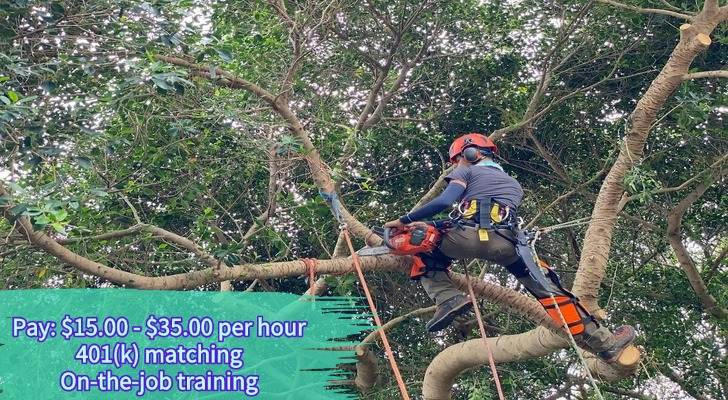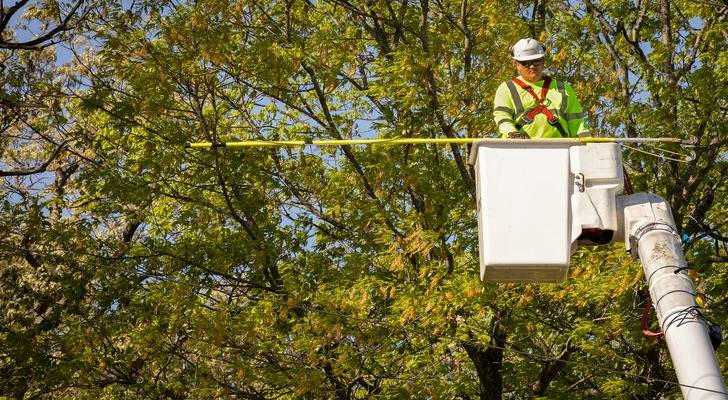Standing on the Treetops to See the Future: Why More People Are Choosing to Become Tree Trimmers?
Tired of low-paying jobs with no future? Looking for meaningful, active work that pays well—without a college degree? More people are turning to tree trimming, a high-demand career offering $15–$35 per hour, benefits, and paid training. It’s more than cutting branches—it’s a path to long-term stability and purpose. In 2025, tree trimming jobs are quickly becoming one of the smartest career moves.

Why Tree Trimming is a Good Career Choice
Are you tired of working long hours in low-paying jobs that lead nowhere? Do you want a job that keeps you active, gives you real skills, and pays well—even if you don’t have a college degree?Unlike temporary or seasonal jobs, tree trimming is considered a good career in many companies. You’re not just hired to “get the job done”—you’re given the tools and support to build a long-term future.
Here are some common benefits offered by employers:
• 401(k) retirement plans,with company matching, helping you save for the future
• On-the-job training,so you learn while earning a paycheck
• Promotion opportunities into higher-paying roles like crew leader or supervisor
• Paid time off,including vacation days and sick leave
• All safety gear and equipment provided,such as helmets, gloves, and climbing gear
These benefits help make this job sustainable—not just physically, but financially and emotionally too.
Carlos’s Story: From Volunteer to Earning Over $30 an Hour
Carlos Mendoza, a 27-year-old from Lansing, Illinois, never planned to become a tree trimmer. But one weekend, after helping clean up fallen trees in a local park, he got curious. Watching professional tree workers climb and use powerful equipment safely inspired him. He wanted to learn more.
Carlos signed up for a local tree service company’s paid training program. He started on the ground, hauling branches and learning the basics. Within a year, he was trained to climb trees and operate heavy machinery. Now he earns over $32 per hour, works steady weekday hours, and feels proud of his work every day.
His journey shows that with curiosity, dedication, and some support, anyone can find a new path in this industry—even without a degree or past experience.
How to Get Started: Training, Costs, and Where to Begin
You don’t need a degree or prior experience to begin. Here are some ways to start:
• Tree service companies often offer in-house training, especially if you commit to working afterward.
• Community colleges or trade schools offer affordable short-term arborist courses, usually a few weeks to a few months.
• Nonprofits or city programs may host workshops or sponsor training programs.
Some certifications may cost between $200–$800, but entry-level jobs usually don’t require them. You can start working and choose to pursue certifications like ISA (International Society of Arboriculture) later.
What the Job Actually Involves
Daily tasks include:
• Operating chainsaws, chippers, and lift trucks
• Climbing or using hydraulic lifts
• Working outdoors in all weather
• Responding to occasional after-hours emergencies
• Collaborating with team members and providing customer service

What Kind of Person Fits This Role?
This job suits individuals who:
• Enjoy outdoor, physical work
• Are safety-minded and dependable
• Like working on a team
• Have or are willing to gain equipment experience
• Prefer structured weekday hours with optional overtime
A Growing Industry with Lasting Demand
Urban growth and changing weather patterns mean more demand for tree maintenance. Whether it's cleaning up storm-damaged trees or keeping parks safe, tree trimmers play a vital role. It’s a career with purpose, progression, and security.
Conclusion: A High-Value Career Above Ground Level
Becoming a tree trimmer is more than a job—it’s a lifestyle and a career. It offers good pay, benefits, and meaningful daily work. If you're ready to grow your future from the ground (or treetop) up, this might be the perfect path for you.
